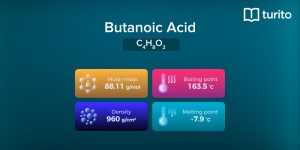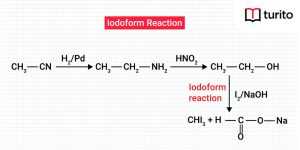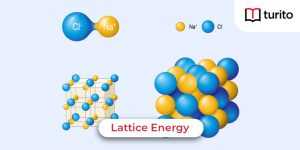Hydrogen Bonding, When you dissolve compounds in water or any other polar solvents, they dissolve easily. While sometimes show no reaction, even if you provide extreme conditions. And this frustrated you while performing chemical experiments in the laboratories.
What is Hydrogen Bonding
Hydrogen bond or hydrogen bonding is defined as the electrostatic force of attraction between a highly positive charge density (+𝛿) containing an H-atom and a highly negative charge density (-𝛿) atom within the molecule. Dotted lines represent hydrogen bonding.
Hydrogen bonding is a special type of strong dipole-dipole interaction. In this type of bonding, hydrogen attached to an electronegative atom, like N, F, or O, is highly electropositive. This hydrogen can readily combine with the negative end of a polar molecule or with molecules with a lone pair of electrons.
Therefore, H-bond is formed either between the molecules of the same substances, between the molecules of different substances or between the two atoms in the same molecule.
Hydrogen Bond Examples
There are many examples of molecules that show H-bonding. Some hydrogen bond examples are given below:
1. H-bonding Occurs Between Two or More Molecules of the Same Substance.
- H-bonding between several molecules of NH3 to form a cluster of (NH3)x

- Formation of (H2O)x cluster

- Formation of (HF)x cluster
- Formation of dimes of formic acid (HCOOH)

2. H-bonding Occurs Between the Molecules of Different Substances.
- Between water (H2O) and acetone (CH3COCH3)

- Between pyridine (C5H5N) and water (H2O)
- Between chloroform (CHCl3) and fatty acid (RCOOH)
- Between acetylene (C2H2) and acetone (CH3COCH3)
Types of Hydrogen Bonding
There are mainly two types of hydrogen bonding. These are
1. Intermolecular H-bonding:
These types of hydrogen bonding occur between several molecules of the same substance or between several molecules of different substances.
In this type of H-bonding, two or more molecules of the same or different substances get polymerised or associated and form a large cluster. The formation of a large cluster is called association or polymerisation.
Intermolecular H-bonding increases the boiling point of the compound and its solubility in water. The compound’s effective molecular weight increases with the association of several compound molecules. Hence, more energy is needed to dissociate the molecules for vaporisation.
An increase in solubility in water is also because of H-bonding between compound and water.
Some examples of intermolecular hydrogen bonding are

2. Intramolecular H-bonding:
Intramolecular hydrogen bonding is that which takes place between two atoms present in the same molecules. In this type of H-bonding, a planar 5-membered or 6-membered chelate ring is obtained. Hence, this type of H-bonding is commonly known as chelation and frequently occurs in organic compounds.
In this type of H-bonding, the interacting atoms should be placed so that there is minimum strain during the closure of the ring.
Intramolecular H-bonding decreases the compound’s boiling point and its solubility in water. It is because the chelation among the ortho-substituted groups controls the probability of intermolecular H-bonding and thus halts the association of the molecules, which would have raised the melting and boiling points.
Chelation is impossible in the corresponding m- and p-isomers because the two groups are far from each other. Therefore, intermolecular H-bonding occurs in such cases, increasing the boiling points.
Some examples of intramolecular hydrogen bonding are

How is Hydrogen Bond Formed?
Let’s take the example of H-bonding in an HF molecule to understand the hydrogen bond formation process.
As the F-atom has a small size and, together with it, the F-atom has a high electronegativity, it results in a polar covalent bond formation between the H-F bond in the HF molecule. It is represented as H𝛿+-F𝛿-. Therefore, the HF molecule behaves as a dipole.
When several such dipoles come nearer to each other, the H-atom carrying a positive charge in H𝛿+-F𝛿- dipole is attracted toward the F-atom containing a negative charge in another dipole. They both get connected by the electrostatic force of attraction called H-bonding.
The final result leads to the formation of (HF)x clusters. The H-bonding in the HF molecules is shown below:
Hydrogen Bonding Conditions
The following situations must be satisfied for the formation of H-bonds in compounds:
1. Presence of Highly Electronegative Atom:
The molecule having H-bond should have a highly electronegative atom like N, F, or O directly linked to H-atom by a covalent bond.
2. Presence of the Atom with Small Size:
The electronegative atom should be of a small size so that the bond between it and hydrogen may become highly polar, and a strong interaction between several such dipoles may occur.
It is also why, equal in the amount of electronegativity between O and Cl, an O-atom can form more H-bonds than Cl-atom.
Effect of Hydrogen Bonding
- Due to H-bonding, the molecules remain associated and more energy is required to break the intermolecular H-bond. Therefore, the substances having H-bonding boil at a higher temperature.
- The solubility of organic compounds in H2O is due to the formation of H-bonds between H2O molecules and organic compounds.
- The increase in the heat of fusion and heat of vaporisation is also due to H-bonding. Hence, a decrease in the impact of H-bonding results in a decrease in the heat of fusion and heat of vaporisation.
- There are many molecular crystals in which the individual molecules are connected through H-bonding.
Applications of Hydrogen Bonding
There are many applications of hydrogen bonding. Some of them are:
1. H-bonding in Single Helix:
In the right-handed helix, groups such as -NH and >C=O are vertically adjacent. These groups link through hydrogen bonding so that >C=O of spiral forms an H-bond with -NH of another spiral. Because of this reason, it shows a spiral shape.
2. H-bonding in Double-Helix DNA:
Two spiral chains in DNA are coiled about one another on a common axis. Hence, it gives a double helix. These spiral chains are linked together through H-bonding between their subunits.
3. H-bonding in Carbohydrates:
The food materials like carbohydrates include glucose, fructose, and sucrose. They all have -OH groups, which are responsible for H-bonding.
4. H-bonding in Paints, Dyes, and Textile Material:
The sticky properties of dyes and paints are matured because of H-bonding. Similarly, substances like glue and honey are sticky due to H-bonding.
5. H-bonding in Clothing Material:
H-bonding is important in thread-making materials like cotton, silk, and synthetic fibres for clothing. This hydrogen bonding makes them rigid and creates tensile strength.
6. Cleaning Action of Soaps and Detergent:
It is also due to H-bonding. The reason is that the polar parts of soap and detergent are water due to hydrogen bonding.
Conclusion
On the groundwork of the above discussion, it is clear that hydrogen bonding is simply a dipole-dipole attraction. However, this dipole-dipole attraction is stronger than other dipole-dipole attractions.
Frequently Asked Questions
1. What is the strength of the hydrogen bond?
The hydrogen bond is weak because it is merely an electrostatic force of attraction, not a chemical bond. The strength of the H-bond increases with the increase of the atom’s electronegativity attached to the H-atom by the covalent bond.
Since the electronegativity of N, O, and F is in order N < O < F, the H-bond strength is also the same as NH3 < H2O < HF.
The order of strength of different bonds is van der Waals forces < H-bond < Covalent bond < Ionic bond.
2. Why do the liquids capable of forming H-bond show high viscosity?
Due to intermolecular H-bonding, the attraction between molecules of hydrogen-bonded liquids increases. This increase in attraction decreases the tendency of the liquids to flow smoothly. The viscosity value increases if the number of associated molecules by H-bonding increases.
It is also due to H-bonding between several H2SO4 molecules that the acid has a high boiling point and is highly viscous. Its highly viscous nature makes the acid a syrupy liquid.
3. Why are NH3, H2O, and HF boiling points greater than PH3, H2S, and HCl?
NH3, H2O, and HF molecules are intermolecular hydrogen bond examples. This type of H-bonding is absent in other molecules of these groups. It is because of H-bonding that these molecules can form their clusters.
More heat energy is essential to break these H-bonds in their clusters in NH3, H2O, and HF molecules. Therefore, the boiling points of these molecules are higher than PH3, H2S, and HCl, respectively.
4. Why is hydrogen bonding important?
Many reasons make H-bonding an important factor. Some of them are mentioned below:
- Because of H-bonding, water molecules attach, and a water cluster forms. You already know about the profits of water. It is essential for sustaining life.
- It helps make wood fibres more rigid, making wood articles like furniture.
- Most of our food is made up of hydrogen bonding like sugar, carbohydrates, etc.
- It determines the structure of various substances like protein, DNA, etc.
- The high water solubility of many compounds, such as ammonia, is explained by hydrogen bonding with water molecules.
- Ice has less density than melted water due to a crystal formation stabilised by hydrogen bonds.

Relevant Articles
Butanoic Acid – Structure, Properties, Uses
Butanoic Acid The carboxylic acid, butanoic acid, has the structural …
Butanoic Acid – Structure, Properties, Uses Read More »
Read More >>What is Iodoform? Characteristics and Uses
Iodoform The formula for Iodoform is CHI3. It is biotic …
What is Iodoform? Characteristics and Uses Read More »
Read More >>Lattice Energy – Explanation, Factors & Formulas
Lattice Energy Lattice energy evaluates the intensity of the ionic …
Lattice Energy – Explanation, Factors & Formulas Read More »
Read More >>Lead Acetate – Definition, Properties, Uses
Lead Acetate Have you ever licked lipstick when you sketch …
Lead Acetate – Definition, Properties, Uses Read More »
Read More >>




















Comments: